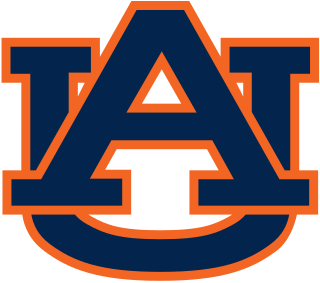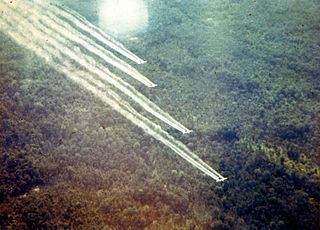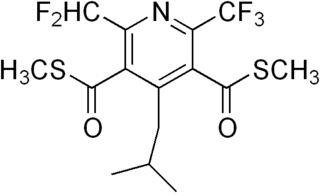
Agent Orange is a chemical herbicide and defoliant, one of the tactical use Rainbow Herbicides.

Herbicides, also commonly known as weed killers, are substances used to control undesired plants, also known as weeds. Selective herbicides control specific weed species while leaving the desired crop relatively unharmed, while non-selective herbicides can be used to clear waste ground, industrial and construction sites, railways and railway embankments as they kill all plant material with which they come into contact. Apart from selective/non-selective, other important distinctions include persistence, means of uptake, and mechanism of action. Historically, products such as common salt and other metal salts were used as herbicides, however, these have gradually fallen out of favor, and in some countries, a number of these are banned due to their persistence in soil, and toxicity and groundwater contamination concerns. Herbicides have also been used in warfare and conflict.

Clopyralid is a selective herbicide used for control of broadleaf weeds, especially thistles and clovers. Clopyralid is in the picolinic acid family of herbicides, which also includes aminopyralid, picloram, triclopyr, and several less common herbicides. For control of creeping thistle, Cirsium arvense, a noxious, perennial weed, clopyralid is one of the few effective herbicides available. It is particularly damaging to peas, tomatoes, and sunflowers, and can render potatoes, lettuce, and spinach inedible. It does not affect grasses.

Glyphosate is a broad-spectrum systemic herbicide and crop desiccant. It is an organophosphorus compound, specifically a phosphonate, which acts by inhibiting the plant enzyme 5-enolpyruvylshikimate-3-phosphate synthase. It is used to kill weeds, especially annual broadleaf weeds and grasses that compete with crops. Its herbicidal effectiveness was discovered by Monsanto chemist John E. Franz in 1970. Monsanto brought it to market for agricultural use in 1974 under the trade name Roundup. Monsanto's last commercially relevant United States patent expired in 2000.

The Dow Chemical Company, officially Dow Inc., is an American multinational corporation headquartered in Midland, Michigan, United States. The company is among the three largest chemical producers in the world.

Auburn University is a public land-grant research university in Auburn, Alabama, US. With more than 24,600 undergraduate students and a total enrollment of more than 30,000 with 1,330 faculty members, Auburn is the second-largest university in Alabama. It is one of the state's two flagship public universities. The university is classified among "R1: Doctoral Universities – Very High Research Activity" and its alumni include five Rhodes Scholars and five Truman Scholars.

The Treaty Oak is a Texas live oak tree in Austin, Texas, United States, and the last surviving member of the Council Oaks, a grove of 14 trees that served as a sacred meeting place for Comanche and Tonkawa tribes before European colonization of the area. Foresters estimate the Treaty Oak to be about 500 years old. Before its vandalism in 1989, the tree's branches had a spread of 127 feet (39 m). The tree is located in Treaty Oak Park, on Baylor Street between 5th and 6th Streets, in Austin's West Line Historic District.

Chlorpyrifos (CPS), also known as Chlorpyrifos ethyl, is an organophosphate pesticide that has been used on crops, animals, and buildings, and in other settings, to kill several pests, including insects and worms. It acts on the nervous systems of insects by inhibiting the acetylcholinesterase enzyme. Chlorpyrifos was patented in 1966 by Dow Chemical Company.

The Auburn Tigers are the athletic teams representing Auburn University, a public four-year coeducational university located in Auburn, Alabama, United States. The Auburn Tigers compete in Division I of the National Collegiate Athletic Association (NCAA) as a member of the Southeastern Conference (SEC).

Alachlor is an herbicide from the chloroacetanilide family. It is an odorless, white solid. The greatest use of alachlor is for control of annual grasses and broadleaf weeds in crops. Use of alachlor is illegal in the European Union and no products containing alachlor are currently registered in the United States.

Picloram is a systemic herbicide used for general woody plant control. It also controls a wide range of broad-leaved weeds, but most grasses are resistant. A chlorinated derivative of picolinic acid, picloram is in the pyridine family of herbicides.

The Rainbow Herbicides are a group of tactical-use chemicals used by the United States military in Southeast Asia during the Vietnam War. Success with Project AGILE field tests with herbicides in South Vietnam in 1961 and inspiration from the British use of herbicides and defoliants during the Malayan Emergency in the 1950s led to the formal herbicidal program Trail Dust. Herbicidal warfare is the use of substances primarily designed to destroy the plant-based ecosystem of an agricultural food production and/or to destroy foliage which provides the enemy cover.

Dithiopyr is a preemergent herbicide for crabgrass control in turf and ornamental grasses. It is effective on 45 grassy and broadleaf weeds. Dithiopyr inhibits root growth of susceptible weeds as well as turf grass and thus should be used only on established turf with a well-developed root system. Its duration of efficacy is approximately 4 months, so lawns should not be reseeded during this time frame following application of the chemical. Dithiopyr acts primarily as a preemergent herbicide but can also be used in early postemergent control of crabgrass.
Auburn University has several notable traditions, many related to its varsity teams, the Auburn Tigers.

Aminopyralid is a selective herbicide used for control of broadleaf weeds, especially thistles and clovers. It is in the picolinic acid family of herbicides, which also includes clopyralid, picloram, triclopyr, and several less common herbicides. It was first registered for use in 2005, in the USA under the brand name "Milestone" and later under various names starting with "Grazon". In the UK it is sold under the brand names Banish, Forefront, Halcyon, Pharaoh, Pro-Banish, Runway, Synero, and Upfront.

SmartStax is a brand of genetically modified seed made through a collaboration between Monsanto Company and Dow Chemical Company. It takes advantage of multiple modes of insect protection and herbicide tolerance. SmartStax takes advantage of Yieldgard VT Triple (Monsanto), Herculex Xtra (Dow), RoundUp Ready 2 (Monsanto), and Liberty Link (Dow). The traits included protect against above-ground insects, below-ground insects, and provide broad herbicide tolerance. It is currently available for corn, but cotton, soybean, and specialty crop variations are to be released. Previously, the most genes artificially added to a single plant was three, but Smartstax includes eight. Smartstax also incorporates Monsanto's Acceleron Seed Treatment System which protects against insects at the earliest stages of development. Smartstax is sold under the Genuity (Monsanto) and Mycogen (Dow) brands.

2,4-Dichlorophenoxyacetic acid is an organic compound with the chemical formula C8H6Cl2O3 which is usually referred to by its ISO common name 2,4-D. It is a systemic herbicide which kills most broadleaf weeds by causing uncontrolled growth in them but most grasses such as cereals, lawn turf, and grassland are relatively unaffected.
The Enlist Weed Control System is an agricultural system that includes seeds for genetically modified crops that are resistant to Enlist and the Enlist herbicide; spraying the herbicide will kill weeds but not the resulting crop. The system was developed by Dow AgroSciences, part of Dow Chemical Company. In October 2014 the system was registered for restricted use in Illinois, Indiana, Iowa, Ohio, South Dakota and Wisconsin by the US Environmental Protection Agency. In 2013, the system was approved by Canada for the same uses.
Toomer's Corner is a street corner located at the intersection of Magnolia Avenue and College Street, and marks the northeastern-most reach of the campus of Auburn University, and the beginning of downtown Auburn, Alabama. Two landmarks are located on Toomer's Corner, the Bank of Auburn and Toomer's Drugs Pharmacy, which was the first establishment in the city with a telegraph, and the intersection is patterned in bricks forming the paw print logo of the Auburn Tigers athletic teams.

Oxyfluorfen is a chemical compound used as an herbicide. It is manufactured by Dow AgroSciences and Adama Agricultural Solutions under the trade names Goal and Galigan. Oxyfluorfen is used to control broadleaf and grassy weeds in a variety of nut, tree fruit, vine, and field crops, especially wine grapes and almonds. It is also used for residential weed control.



















